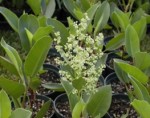Scientific Name: Rumex skottsbergii
Endemic: Hawaii Island
Description: Very unique, medium sized shrubs three to five feet tall with bright red stems and fairly thick leaves that are usually flat and elliptical in shape. Each leaf has a distinct yellow midrib that contrasts very well with the foliage and red stems. The petioles, which connect the leaf to the stem, are also red with green streaks. When in bloom a large inflorescence of greenish-yellow flowers protrude up above the plant. Once pollinated paper-like seed pods resembling those of ‘a’ali’i (Dodonea viscosa), only much smaller, develop.
Distribution: This species is naturally only found on the island of Hawai’i in both pahoehoe and ‘a’a lava fields of Kona, Puna and southern Ka’u. Other native species closely resembling this one can be found on the Big Island as well as other islands in the Hawaiian chain.
Cultural Uses: Although not commonly used, most likely due to the scarcity of the plant, the bright greenish-yellow flower clusters and seed pods look great in lei. This is one of those flowers that will make people say: “Aunty (or Uncle), what kine flower is dat in your lei? Unreal la dat!” and then you say: “Yeah, I know. It’s…….pawale” and den dey goin say: “Pa— what?” and den you say: “PAWALE, you know Rumex skottsbergii!?!?” and then watch the blank look on their face.
Landscape Use and Care: Like I said earlier, this plant is naturally found on lava fields (cooled down lava fields of course, not the molten kind, but still da buggah is hot!) so you want to plant it in the sunniest location of your garden, although it will handle partial shade, it will look best in full sun. Planting it around rocks or in a rocky location makes this plant really stand out and resembles its natural habitat making it feel at home. This plant also likes well drained soil and dry conditions, if you have well drained soil giving it a good soaking every 2-3 days is best, eventually after a few weeks cutting back the watering to only when needed. Few pests bother this plant with the exception of slugs that may chomp on new shoots.
Pawale
